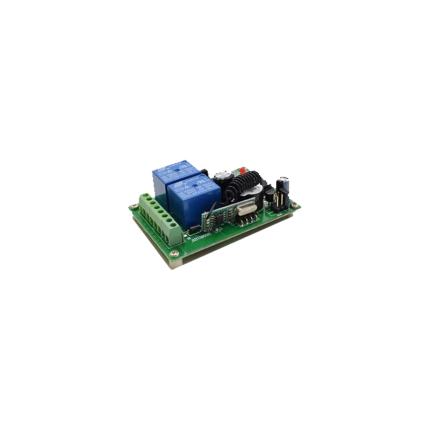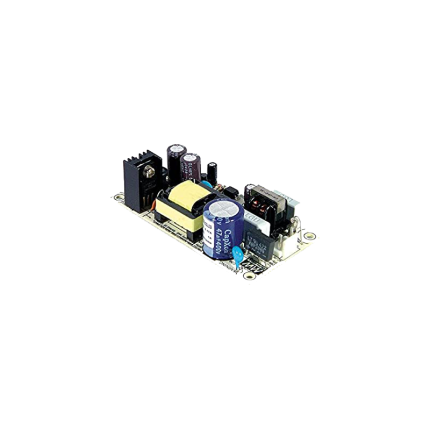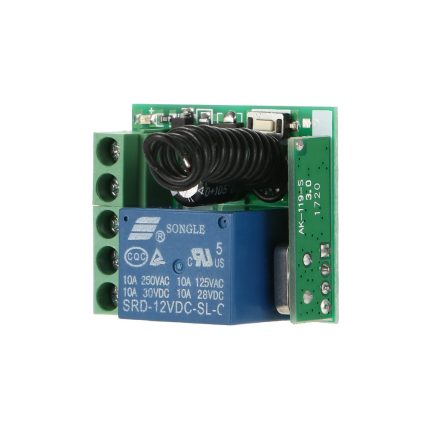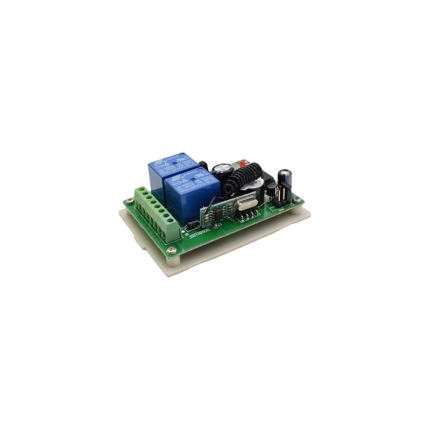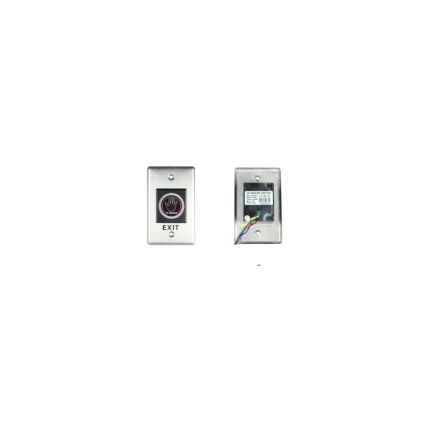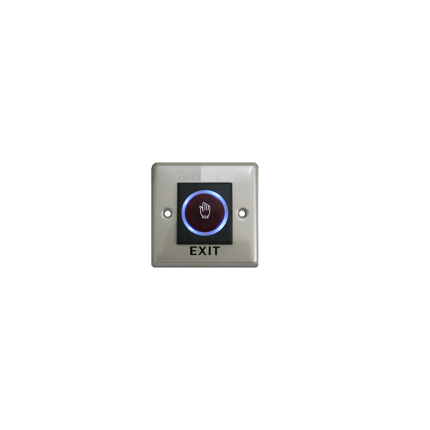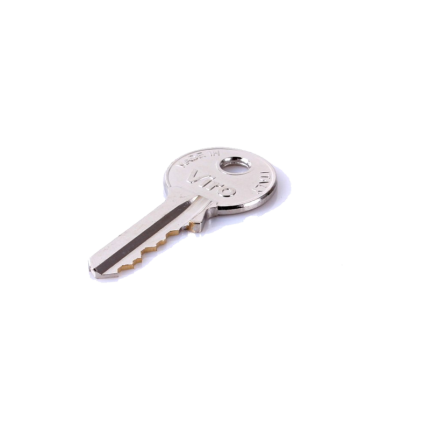Shop
Radio receiver RG315-12V2C
Ship or pick up from our office.
Radio receiver RG315-12V2C
*DC 12 V *2-CH *315 MHz * Compatible with Homelink systemPower converters – AC 24 V to DC 15 V
Ship or pick up from our office.
Power converters - AC 24 V to DC 15 V
A "Power converter - AC 24 V to DC 15 V" is a device that transforms an alternating current (AC) input of 24 volts into a direct current (DC) output of 15 volts. Here's a breakdown of what that means and how it works: AC (Alternating Current): This is the type of electricity typically supplied by wall outlets in homes and businesses. The voltage constantly changes direction, flowing back and forth. 24V AC is a common voltage for certain low-voltage control systems, industrial equipment, and sometimes HVAC systems. DC (Direct Current): This is the type of electricity that flows in only one direction. Most electronic devices, like phones, laptops, and many sensors or control circuits, require DC power. How an AC to DC Converter Works: An AC to DC converter (also known as a rectifier or power supply) typically involves several stages:- Step-Down Transformer: The initial 24V AC is usually too high for direct conversion to 15V DC. A transformer "steps down" this AC voltage to a lower, more manageable AC voltage.
- Rectification: This is the core of the AC to DC conversion. Diodes are used to convert the alternating current into a pulsating direct current. There are different types of rectifiers (half-wave, full-wave, bridge) that achieve this with varying degrees of efficiency and ripple.
- Smoothing (Filtering): The pulsating DC output from the rectifier isn't perfectly smooth. Capacitors are used to "smooth out" these ripples, creating a more stable DC voltage.
- Regulation: To ensure a precise and constant 15V DC output, a voltage regulator is often employed. This circuit maintains the output voltage at the desired level, even if the input voltage fluctuates or the load on the power supply changes.
- Industrial control systems: Powering sensors, actuators, and control circuits that operate on 15VDC.
- HVAC systems: Often 24VAC is used for thermostats and control panels, but some components within the system might require 15VDC.
- Security systems: Powering cameras, access control devices, and other equipment.
- Lighting systems: Especially in specialized LED lighting setups.
- Custom electronics projects: Where a stable 15VDC is needed from an existing 24VAC infrastructure.
- Output current (Amps): How much current the connected device needs.
- Power rating (Watts): The total power the converter can deliver.
- Efficiency: How much energy is lost during the conversion process (higher efficiency means less heat and less wasted energy).
- Protection features: Over-voltage, over-current, short-circuit protection for safety and device longevity.
- Form factor: Whether it's an open-frame, enclosed, or DIN-rail mount design.
Power converter – AC 24 V to DC 12 V
Ship or pick up from our office.
Power converter - AC 24 V to DC 12 V
A power converter - AC 24 V to DC 12 V is a device that transforms alternating current (AC) at 24 volts into direct current (DC) at 12 volts. These are also commonly referred to as AC/DC power adapters or rectifiers. How it Works ⚙️ The conversion process from AC to DC typically involves several key stages:- Step-Down Transformer: The 24V AC input first goes through a transformer. This component reduces the voltage from 24V AC to a lower AC voltage, although not necessarily directly to 12V DC at this stage. It's about getting to a more manageable voltage level for the subsequent steps.
- Rectification: The reduced AC voltage then enters a rectifier circuit, usually made of diodes. Diodes allow current to flow in only one direction, effectively converting the alternating current (which periodically reverses direction) into a pulsating direct current (which flows in one direction but isn't smooth).
- Half-wave rectifiers block half of the AC waveform.
- Full-wave rectifiers (like a bridge rectifier) use both halves of the AC waveform, resulting in a smoother, more efficient conversion.
- Smoothing (Filtering): The pulsating DC output from the rectifier isn't perfectly steady. It has "ripples" or fluctuations. To smooth this out, capacitors are used. These components store electrical energy during the peaks of the waveform and release it during the dips, creating a much more stable and continuous DC voltage.
- Voltage Regulation: Finally, a voltage regulator circuit ensures that the output voltage remains consistently at the desired 12V DC, regardless of minor fluctuations in the input AC voltage or changes in the load connected to the converter. This also helps protect the connected device from voltage spikes or drops.
- CCTV cameras and surveillance systems: Many security cameras operate on 12V DC, and these converters allow them to be powered from a 24V AC power supply (which is often used in larger installations for longer cable runs due to less voltage drop).
- Low-voltage lighting: Converting 24V AC to 12V DC for certain LED lights or other low-voltage lighting systems.
- Industrial control systems: Some industrial equipment or sensors might use 12V DC power while the facility's power supply is 24V AC.
- Automotive accessories (with specific input needs): While most car systems are 12V DC, there might be niche applications where a 24V AC source needs to be converted.
- Various electronic projects and devices that require a stable 12V DC supply from an AC input.
Radio receiver RG315-12V1C
Ship or pick up from our office.
Radio receiver RG315-12V1C
* DC 12 V * 1 Channel * 315 MHz * Compatible with the Homelink system The RG315-12V1C is a radio receiver designed for automatic gate operators and garage doors. 🚧 It operates at a frequency of 315 MHz and is compatible with a wide range of gate operators, including Italian, Chinese, swing gate, sliding gate, and overhead garage door systems. Key Features- Operating Frequency: 315 MHz
- Voltage: 12V DC
- Compatibility: Works with various gate operators and garage doors.
- Capacity: Can store up to 100 remote controls.
- Signal Penetration: Its wireless RF signals can effectively pass through walls, floors, doors, and windows.
- Design: It's compact, lightweight, portable, and easy to install.
- Multiple Units: Multiple RG315-12V1C units can be used in the same location without interference.
- Gate Openers: Allowing remote control of swing gates and sliding gates.
- Garage Door Openers: Enabling wireless operation of overhead garage doors.
Radio receiver RG315-24V1C
Ship or pick up from our office.
Radio receiver RG315-24V1C
*DC 24 V *1 Channel *315 MHz * Compatible with the Homelink system A gate opener radio receiver is an electronic device that acts as the "ear" for an automatic gate system. Its primary function is to receive radio signals from a remote control (transmitter) and, upon recognizing a valid signal, instruct the gate opener's control board to activate the gate motor to open or close the gate. How it Works Here's a breakdown of how a gate opener radio receiver typically operates:- Signal Reception: When you press a button on your remote control, it sends out a radio signal at a specific frequency (e.g., 300MHz, 310MHz, 318MHz, 433MHz).
- Compatibility: The receiver is tuned to the same frequency as the remote control. For the system to work, the receiver and remote must also be compatible in terms of brand and radio protocol (e.g., rolling code, fixed code).
- Decoding: The receiver decodes the radio signal it receives. Modern systems often use "rolling code" technology for enhanced security, where the code changes with each use, making it very difficult for unauthorized individuals to duplicate or intercept.
- Command Relay: Once the signal is decoded and validated, the receiver relays the command to the gate opener's main control board.
- Gate Activation: The control board then triggers the gate motor, causing the gate to open or close.
- Internal vs. External: Some gate openers have built-in receivers, while others utilize external receivers that connect to the system. External receivers can be used as replacements if an internal one fails or to add functionality.
- Channels: Receivers can be single-channel (controlling one gate) or multi-channel (controlling multiple gates or other devices).
- Frequency: Receivers operate on specific radio frequencies, and it's crucial that the remote control matches the receiver's frequency.
- Security: Newer receivers often incorporate advanced security features like rolling codes or encrypted protocols to prevent unauthorized access.
- Range: The effective range of a receiver varies, typically from 50 to 100 feet, but some long-range receivers can extend this distance.
- Power Input: Receivers can operate on various voltages, such as 12V DC, 24V DC, or even 110V AC, depending on the gate opener system.
- Compatibility: While some receivers are universal, many are designed to work with specific brands or types of remote controls.
- Convenience: It allows users to open and close gates remotely, eliminating the need to manually operate them.
- Security: With coded and encrypted signals, it ensures that only authorized individuals can access the property.
- Flexibility: Many receivers can be programmed to work with multiple remote controls, accommodating various users.
Radio receiver RG433-24V2C
Ship or pick up from our office.
Radio receiver RG433-24V2C
* DC 24 V * 2 Channels * 433 MHz The RG433-24V2C is a 433 MHz radio receiver primarily used in automated gate systems to control the opening and closing of gates via a remote control. It acts as a crucial component for convenient and secure remote access. Key Features & Specifications 🔑- Frequency: Operates at 433 MHz, a common frequency for remote control applications.
- Channels: The "2C" in its designation suggests it has 2 channels, meaning it can control two different functions or devices.
- Voltage: It typically operates on a DC 24V power supply.
- Application: Primarily designed for gate opener remote control systems.
- Type: It can be an external receiver, often used as a backup or for added functionality in gate automation setups.
- Manufacturer: It's manufactured by Royal Electronics Technology Center Co. (RETCC).
Radio receiver RG433-12V2C
Ship or pick up from our office.
Radio receiver RG433-12V2C
*DC 12 V *2-CH *433 MHzRadio receiver RG433-24V1C
Ship or pick up from our office.
Radio receiver RG433-24V1C
* DC 24 V * 1 Channel * 433 MHz The Radio receiver RG433-24V1C is an electronic device primarily used in automated gate systems. It receives radio signals from a remote control, enabling it to open and close an automatic gate. 🚧 Key Features and Specifications- Frequency: It operates at 433 MHz, a common frequency for remote control applications.
- Voltage: It requires a DC 24V power supply. The "1C" in its name likely refers to its single channel capability, meaning it controls one function (e.g., opening/closing a single gate).
- Function: Its core function is to receive signals, decode commands, and then control the connected gate opener.
- Type: These receivers can be either internal (built into the gate opener unit) or external. External receivers are often used for added functionality or as backup.
- Physical Characteristics: It's a compact device, typically weighing around 0.08 kg with dimensions of approximately 8 × 6 × 3 cm.
- Remote Access: Allowing users to open and close gates wirelessly using a remote control.
- Security: Providing convenient and secure access to properties.
In essence, the RG433-24V1C acts as the "ear" for your automated gate, listening for commands from your remote control to manage access.
Radio receiver RG433-12V1C
Ship or pick up from our office.
Radio receiver RG433-12V1C
* DC 12 V * 1 Channel * 433 MHz The RG433-12V1C is a single-channel radio receiver operating at 433 MHz, specifically designed for remote control of automatic gates. It acts as a crucial component in automated gate systems, allowing users to open and close gates wirelessly using a remote control. This receiver is compact and lightweight, making it easy to install. It functions by receiving radio signals from a remote, decoding the commands, and then controlling the gate opener mechanism. Key Features- Frequency: Operates at 433 MHz, a common frequency for remote control devices.
- Channels: It's a 1-channel receiver, meaning it can control one specific function or device (in this case, typically opening/closing a single gate).
- Voltage: Designed to operate with a 12V DC power supply.
- Application: Primarily used in automated gate systems for remote access control.
- Dimensions: Approximately 8 × 6 × 3 cm.
- Weight: Around 0.08 kg.
- Compatibility: Compatible with various types of gate openers, including single swing, double swing, and sliding gates.

